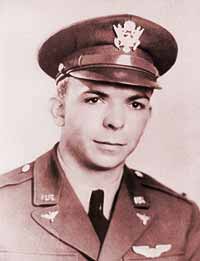Gordon H. Sterling, Jr. was born in Connecticut on 30 June 1919. He was serving as a Second Lieutenant, 46th Pursuit Squardon, 15th Pursuit Group, at Pearl Harbor, Hawaii, when the Japanese attacked the islands on 7 December 1941. Lieutenant Sterling was killed during the attack and his body was not recovered. There is a memorial stone for the Lieutenant at Arlington National Cemetery.
Courtesy of Flight Journal
Quietly watching the drama unfold on 7 Deceember 1941 was Second Lieutenant Gordon H. Sterling Jr., the 46th PS assistant flight engineer. Gordon had passed his flight tests but had not progressed as rapidly as the other pilots had in formation and gunnery. He saw that other P-36s were beginning to taxi out and that the P-36 Norris intended to fly was going to be left behind. The immediate need for a complete formation spurred Sterling to action.
He climbed into the idling plane, determined to fight to the finish. He gave his watch to the crew chief, Staff Sergeant Turner, and said, “Give this to my mother! I’m not coming back!”
Sterling had scheduled an afternoon date with his fiancée, 2nd Lt. Ada M. “Peggy” Olsson, a nurse at nearby Schofield Barracks Station Hospital. The Japanese attack canceled it.
When Sanders broke away from Fujita after the initial attack, he gained 2,000 feet of altitude, turned back toward the combat and saw Sterling behind Okamoto, firing. Sanders immediately knew that Sterling was in serious trouble because Fujita was now on Sterling’s tail and closing fast. With Fujita firing at him, Sterling forgot about Okamoto’s Zero and increased the dive angle. Sanders had his throttle to the stop and latched onto Fujita’s tail, but he was too far away and too late. Fujita got hits all over Sterling’s airplane, and it began to smoke. Fire was streaming from the aircraft as it dived through the cloudbank straight into the bay. Sanders began to register hits on Fujita’s airplane, which was badly damaged. Their race for the cloudbank saved both Okamoto and Fujita and ended the action.
Sanders recalled, “Just as I closed in, he [Fujita] got a burst at Sterling, whose plane burst into flames. Four of us then went into a dive: the Japanese in front [Okamoto]; then Sterling, firing at him; then another Japanese [Fujita], and then me. We plunged into the overcast that way. I was some distance behind, and when I came out, there was no sign of the other planes. The way they had been going, they couldn’t have pulled out, so it was obvious that all three went into the sea.” Later, Japanese records would show that only Sterling crashed. Not knowing that, Sanders gave Sterling a victory credit over Okamoto.
In 1942, U.S. Army Air Force “Missing Air Crew Reports” (MACR) attempted to account for lost airmen. Initial coverage was extremely poor, as few units wrote MACRs during the early days of the War. In the immediate postwar era, many MACR files were written in an attempt to make up for earlier omissions. Funding, however, ran out for WW II paperwork, and the results are still not comprehensive. There isn’t an MACR for Sterling.
“Missing in action” is a term used by the Casualty and Memorial Affairs Branch of the U.S. Army to establish a pay scale for a missing serviceman’s next of kin. An MIA is downgraded to “body non-recoverable” (BNR) when the person is declared dead. The American Graves Registration Service’s Board of Review met on April 26, 1948, to affirm the death of 2nd Lt. Gordon H. Sterling Jr. as BNR.
A further records investigation by the USAAF reported on March 7, 1949, “In view of the negative results of efforts to correlate this case with unknowns recovered from the pertinent area, it appears that Lt. Sterling was lost at sea, off the Oahu coast, as a result of enemy action, and under such circumstances as to preclude the possibility of recovery of his remains.”
Phil Rasmussen, Sterling’s roommate, reflects, “Gordon, to my knowledge, had no premonitions about being shot down.” Gordon wrote to his parents in early November 1941, “Phil and I have decided that if either of us has to crash, we’ll do it where they can pick us up so that the other can bring us home. That’s a good arrangement except it’s more likely to be Phil that brings me home.” Phil Rasmussen is still waiting to bring Gordon home.
Gordon H. Sterling, Jr
- Second Lieutenant, U.S. Army Air Forces
- Service # 0-411852
- 46th Pursuit Squadron, 15th Pursuit Group
- Entered the Service from: Connecticut
- Died: 7-Dec-41
- Missing in Action or Buried at Sea
- Tablets of the Missing at Honolulu Memorial
- Honolulu, Hawaii
- Awards: Distinguished Flying Cross, Purple Heart
STERLING, GORDON H JR
- 2ND LT US ARMY
- WORLD WAR II
- DATE OF BIRTH: 06/30/1919
- DATE OF DEATH: 12/07/1941
- BURIED AT: SECTION MI SITE 159
ARLINGTON NATIONAL CEMETERY
Michael Robert Patterson was born in Arlington and is the son of a former officer of the US Army. So it was no wonder that sooner or later his interests drew him to American history and especially to American military history. Many of his articles can be found on renowned portals like the New York Times, Washingtonpost or Wikipedia.
Reviewed by: Michael Howard

